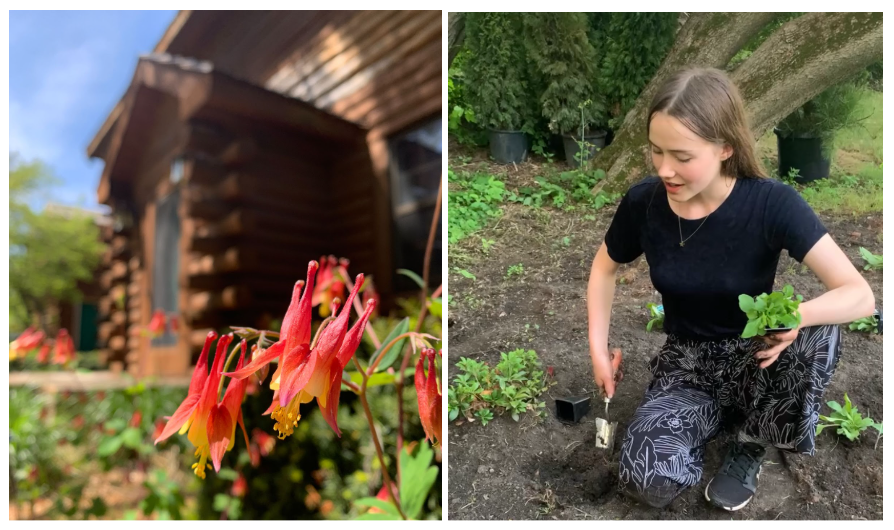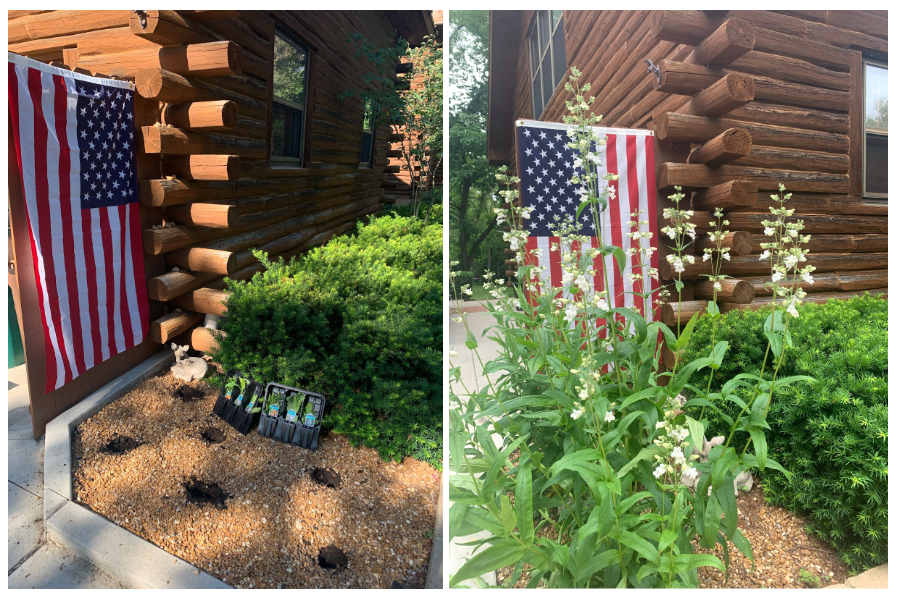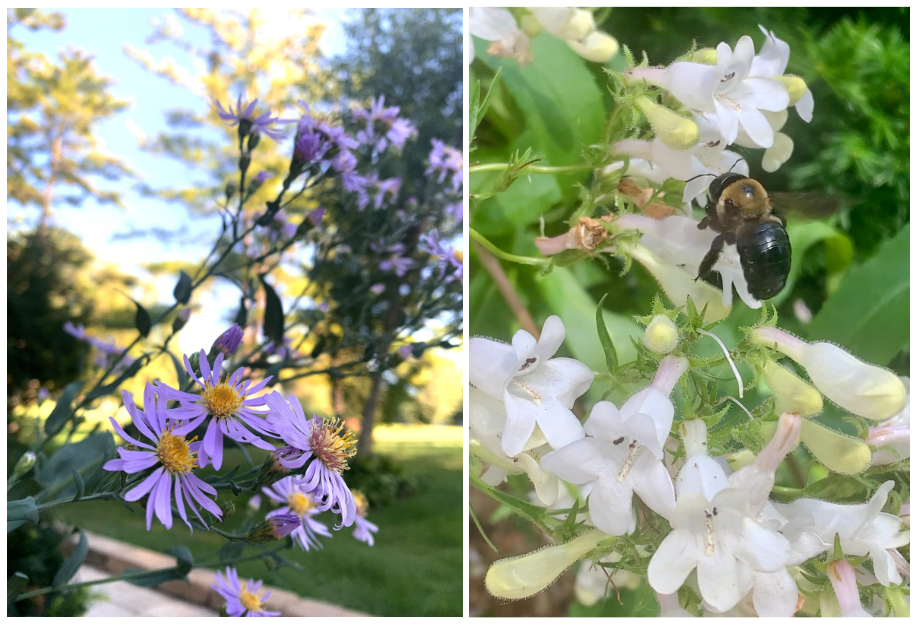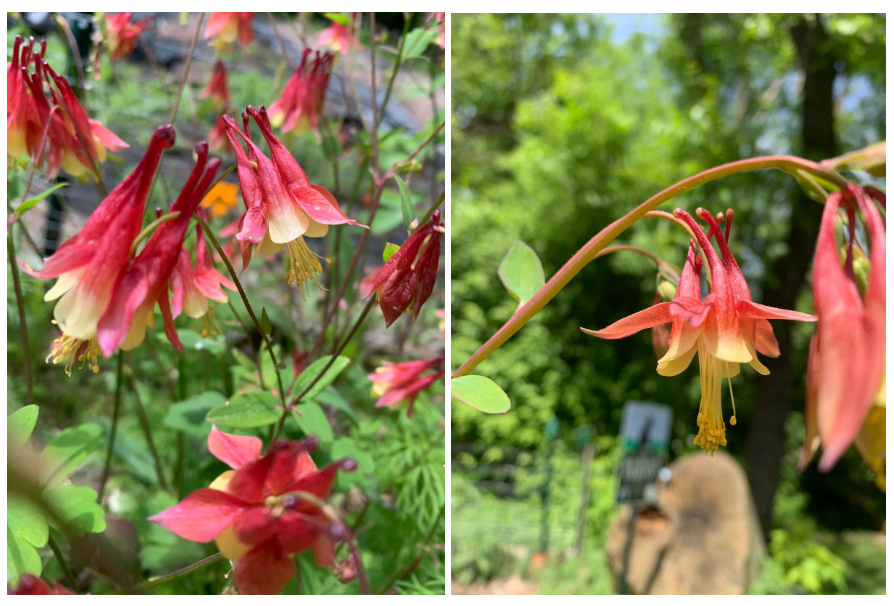This story was submitted by Larinda Frushour. It documents her journey planting pollinator gardens for her Girl Scout Gold Award project.

Eastern columbine plants blooming in front of a home (on the left)
Larinda planting seedlings in the garden (on the right)
The term “native plant” has become somewhat of a buzzword in modern times. For homeowners looking to start a garden, it begs the question: Does planting native really make a difference?
Native plants are those that have naturally occurred in an area for thousands of years. In that time, they created an essential basis for our local wildlife. Today, much of that wildlife is threatened.
The native plant movement aims to restore the wildlife that had once thrived on our developed land. But it also generates surprising benefits for us as gardeners, from protecting our health to reducing our water bill.
I was just beginning to learn about the benefits of native plants when I reached out to Garden for Wildlife in the summer of 2023.
That summer, in my final year of being a Girl Scout, I had been working on my culminating Gold Award project. This was a 130 hour project dedicated to conservation outreach and habitat restoration for pollinators, with an emphasis on monarchs.
A key culprit for our global decline in pollinators? Habitat loss. Garden for Wildlife provided an avenue to address this, with a wildlife-centered selection of plants that were not only beautiful, but perfectly suited for my area.
I wanted to use native plants to create perennial pollinator gardens, resembling the prairie that once covered much of my home state (Illinois). These would provide pockets of nectar for bees, birds, butterflies, and other pollinators traversing over the ecological desert that is a traditional grass lawn. Garden for Wildlife kindly donated the plants for my project.

A landscaping transformation with the Monarch Munchables Collection
Before and After, 2023 - 2024 Growing Seasons
Why I Chose to Plant Native
Unfortunately, a lot of the plants traditionally sold in garden stores pose a losing battle for gardeners. Exotic species are more likely to require heavy watering and pesticide usage. While exotic plants can still be beneficial, they do not reap the same rewards as native plants. For example, the popular butterfly bush attracts butterflies to its purple flowers, but it’s invasive, crowding out native species like milkweed that serve as host plants for the monarch butterfly.
It was important to me to plant native for multiple reasons. First, the wildlife in my region evolved to live on the plants that were once here, so native plants would provide pollinators the best chance of survival.
Even for gardeners less concerned about protecting wildlife, there are many benefits to planting native, like ease of maintenance. Native plants are well adapted to thrive under their regional soil conditions (sandy, rocky, clay - no problem) and weather patterns (rainy, drought, high heat, etc.) They require less intensive upkeep and are overall cheaper to maintain.
This also means native plants offer a degree of grace for less experienced gardeners (i.e., they’re harder to kill.) Once established, native perennials root deeply into the soil, which also aids in preventing soil erosion and runoff.
Another benefit of these low maintenance plants is that they don’t need pesticides or fertilizer- It’s actually better not to use these chemicals at all. Pesticides don’t discriminate. They are not only toxic to the pests we want to ward off, but to the beneficial wildlife as well. Not to mention, chemical pesticides are known to be health hazardous to people and pets.

Sky blue aster reaching towards the sunlight (on the left)
A bee pollinates the white blooms of a foxglove beardtongue wildflower (on the right)
Planning and Planting Native Pollinator Gardens
So how did I put the vision into action? First, I selected several areas around my home, each roughly 20 square feet in area, to create pollinator gardens.
 From there, Garden for Wildlife made it surprisingly easy. I simply entered my zip code on the website and browsed a variety of native plant collections for Northern Illinois. Some collections required full sun, while others needed part shade or full shade. The level of sunlight exposure helped me determine what to grow in which garden.
From there, Garden for Wildlife made it surprisingly easy. I simply entered my zip code on the website and browsed a variety of native plant collections for Northern Illinois. Some collections required full sun, while others needed part shade or full shade. The level of sunlight exposure helped me determine what to grow in which garden.
Next thing I knew, the plants were on my doorstep!
After planning, the process of planting was fairly simple. For each garden, I used a small trowel to dig staggered holes about one to two feet apart. I gently broke up the roots with my fingers and buried each plant to sit at ground-level. Afterwards, I made sure to lightly pat down the soil and water thoroughly.
One recommendation for anyone starting a garden is to use a quality landscaping cloth or some kind of ground covering to prevent weeds from taking over. This saves a lot of time in the long run.
Plant Spotlight: Eastern Columbine
A favorite plant I’d like to highlight is the eastern columbine (Aquilegia canadensis), known to attract birds, butterflies, and people. It boasts elegant, bell shaped flowers with stunning bright pink and yellow petals.
I planted eastern columbine in the flower boxes surrounding my vegetable garden. As a result, my vegetable garden actually performed better! With bright flowers to attract pollinators, more of the flowers on my tomatoes and cucumbers were pollinated and turned into edible fruit.
A word of advice I would offer to new gardeners is to be patient. Perennials generally take time to establish themselves, especially if you plant them later in the growing season, like I did. I planted my gardens in July and nurtured them until they bloomed the following spring. After that initial investment, native perennials will come back with fuller and fuller blooms each year.
Bringing Your Garden to Life
For anyone who is still on the fence about starting a pollinator garden, I want to mention one last benefit: mental health. Spending time in nature is proven to boost our energy, productivity, and overall happiness. When I get up close, get my hands dirty, and interact with nature, I get a sense of mental clarity. And in the summers, when I walk outside to observe a colorful miniature world, buzzing with life, I am filled with wonder.
Throughout the entire process, I was surprised by how easy and rewarding it was to create a beautiful pollinator haven. And the resilience of native plants makes gardening a realistic part of a busy life.
Right now, nature needs us, and we need nature. When we bring it closer, we create a cascading positive impact on people and the planet.
About the Author
 Larinda first connected with Garden for Wildlife as a highschooler pursuing her Girl Scout Gold Award project on pollinators. Today, as a student at the University of Illinois, she continues to follow her passion for conservation outreach, majoring in environmental science. Each year, she cultivates a vegetable garden, and invites bees and butterflies to her yard with a colorful array of pollinator friendly plants! Larinda hopes to share the joy of nature with others, rewriting "gloom and doom" climate news from an uplifting, actionable perspective.
Larinda first connected with Garden for Wildlife as a highschooler pursuing her Girl Scout Gold Award project on pollinators. Today, as a student at the University of Illinois, she continues to follow her passion for conservation outreach, majoring in environmental science. Each year, she cultivates a vegetable garden, and invites bees and butterflies to her yard with a colorful array of pollinator friendly plants! Larinda hopes to share the joy of nature with others, rewriting "gloom and doom" climate news from an uplifting, actionable perspective.

